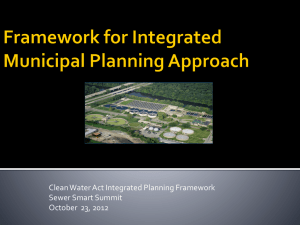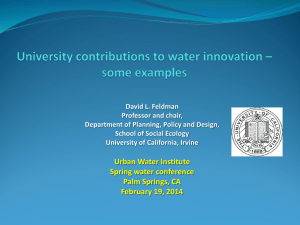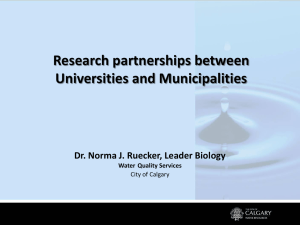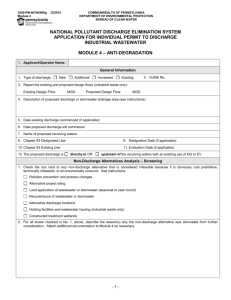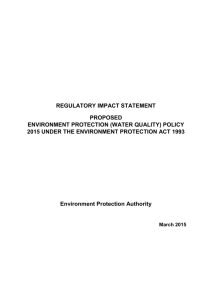Industrial water and Wastewater Permitting in Colorado
advertisement
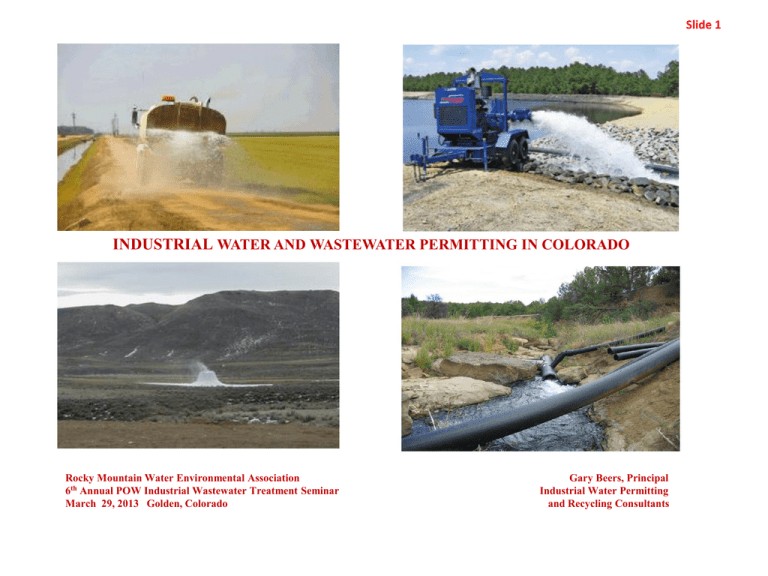
Slide 1 INDUSTRIAL WATER AND WASTEWATER PERMITTING IN COLORADO Rocky Mountain Water Environmental Association 6th Annual POW Industrial Wastewater Treatment Seminar March 29, 2013 Golden, Colorado Gary Beers, Principal Industrial Water Permitting and Recycling Consultants Release to surface water Release to land Release to ground water Slide 2 The industrial water or industrial wastewater management process starts here…. Just follow the arrows and the pathways to permitting for releases to the environment are obvious Slide 3 Key Terms Domestic Sources Non-domestic Sources Industrial or Commercial Activities Simple activity with minimal treatment Release of water to the environment Domestic Wastewater Industrial Water (Process Water) Complex activity with substantial treatment Release of water the environment Industrial Wastewater Slide 4 Delegation of Water Authorities Clean Water Act (1972) Environmental Protection Agency National Discharge Pollution Elimination System (NPDES) ( except for federal facilities and tribal lands) Delegated to Colorado on March 27, 1975 Colorado Water Quality Control Act (1966) Colorado Water Quality Control Commission Implementation - Water Quality Control Division Releases to Ground water Releases to surface water Slide 5 Delegation of National Discharge Elimination System (NPDES ) Components POINT SOURCE DISCHARGE Type Municipal Facilities Industrial Facilities Federal Facilities and Tribal Lands Agricultural Operations Treated Effluent Stormwater Reclaimed Water Biosolids Pretreatment Treated Effluent Outfall UIC Well Oil/Gas Other Non-UIC Well or Pond Stormwater Oil/Gas Non-Oil/Gas Reclaimed Water (Reuse) Residuals Treated Effluent Stormwater Reclaimed Water (Reuse) Biosolids Residuals Return Flow Confined Animal Operations (CAFO) (livestock) Destination Surface Water Groundwater Surface Water Land Land WWTF Surface Water Groundwater Groundwater Groundwater Surface Water Surface Water Land Land Surface Water Groundwater Surface Water Land Land Land Surface Water Groundwater Surface Water Groundwater NPDES COMPONENT DELEGATED ? STATE-ONLY PROGRAM ? YES --YES --NO NO YES YES NO --YES YES ----NO --NO --NO NO EXEMPT EXEMPT YES YES NO YES NO YES SHARED SHARED NO NO --YES NO NO YES YES --YES --YES ----EXEMPT EXEMPT NO NO Slide 6 Implementation of Senate Bill 89-181 Subsection 25-8-202(7) of the 1989 amendments to the state Water Quality Control Act (SB 181) restates and clarifies existing law, and provides a procedure for coordination between state agencies vested with responsibilities to implement water-quality protection of state waters. Key among the provisions is the requirement that the Water Quality Control Commission (WQCC) and the Water Quality Control Division (WQCD) recognize the water-quality responsibilities of the following entities, referred to in the subsection as the “implementing agencies”: Division of Reclamation, Mining, and Safety (DRMS) State Engineer Colorado Oil and Gas Conservation Commission Division of Oil and Public Safety (Oil Inspector) and the state agency responsible for activities related to the federal “Resource Conservation and Recovery Act of 1975” as amended. Currently, this is the Hazardous Material and Waste Management Division located in the Colorado Department of Public Health and Environment. The WQCC is to remain solely responsible for the adoption of water quality standards and classifications for state waters. Each implementing agency is to apply these water quality standards and classifications adopted by the WQCC through their own programs after consultation with the WQCC and the WQCD. Generally, application of the standards and classifications would be limited to nonpoint surface discharges and to subsurface discharges as the WQCD remains solely responsible for the issuance and enforcement of permits for point-source discharges into state surface waters. The implementing agencies are to specify applicable points of compliance for groundwater discharges. The points of compliance are to be adopted in accordance with criteria established through public rulemaking following consultation with the WQCC and the WQCD. WQCD and Implementing State Agencies Industrial Water Activity EPA Region 8 Colorado Agency Department of Natural Resources Department of Health and Environment Water Quality Control Division Hazardous Materials and Waste Management Division Oil and Gas Conservation Commission Division of Reclamation Mining and Safety Division of Water Resources Slide 7 Department of Labor and Employment Department of Agriculture Division of Oil and Public Safety Inspection and Customer Services Division Permitting : Discharges to Surface Water Federal Facilities X Tribal Facilities X Other Facilities X X Permitting : Underground Injection Wells Oil/Gas Facilities Other Facilities X X Permitting : Discharges to Ground Water or Land (Implementing Agencies) Hazardous Waste X Solid Waste X Oil/Gas X Mining X Underground Tanks X Livestock Feedlots X Other X Recycling Recycling Beneficial Use Commercial Product X X X X X X X X Slide 8 TYPES OF PERMITS ISSUED BY WQCD’S PERMITS SECTION TYPE SECTOR NAME Name Individual Permit Domestic Commerce and Industry Sewage Systems Construction MS4 Authorization CO----------- Ground Water Industrial General Permit Surface Water Discharge Number Reclaimed Water Surface Water Discharge CO----------- Ground Water CO----------- Aquatic Animal Production Commercial Washing Outdoor Structures Coal Mining Process Water and Stormwater Hydrostatic Testing of Pipelines, etc Metal Mining Industry Stormwater Non-Contact Cooling Water Non-Extractive Industries Stormwater TOTAL COG130000 COG607000 COG850000 COG604000 COR040000 COG605000 COR900000 NoExposure Exclusion Stormwater CONOX000 Pesticides Application Produced Water Treatment Facilities Sand & Gravel Mining Wastewater/Stormwater Sand & Gravel Mining Processing Stormwater Subterranean Dewatering & Well Development Water Treatment Plant Wastewater Discharge Domestic WWTF with Chronic Low Flow Domestic Wastewater Treatment Facilities Domestic Septic Treatment Systems Domestic On-site Systems ISDS Domestic On-site Systems ISDS – No Wells Domestic Lagoon Systems Domestic Discharge Land Disposal Domestic Discharge Land Treatment Domestic Discharge Land Treatment Ag Rate Construction Dewatering Remediation Discharges to Surface Water Remediation Discharges to Ground Water Stormwater Construction MS4 Cherry Creek Reservoir Basin MS4 Non-Standard MS4 Standard COG860000 COG840000 COG500000 COG340000 COG603000 COG641000 COG588000 COG589000 COX620000 COX621000 COX622000 COX630000 COX631000 COX632000 COX633000 COG070000 COG315000 COG316000 COR030000 COR080000 COR070000 COR090000 TOTAL COE000000 COE000000 TOTAL Treaters Users NUMBER ISSUED (9,916) 230 100 90 10 430 13 8 4 31 100 17 900 183 1,200 3 32 200 48 13 67 30 15 38 32 28 35 32 3 569 28 21 3,723 116 5 20 8,476 24 266 290 Industrial Water or Wastewater can be Released Under Other Regulatory Frameworks Slide 9 Industrial water or wastewater Traditional Framework Management and release to the environment as a unwanted material. (Negative value) Recyclable Product Framework Commercial Product Framework Management and release to the environment as a material with a beneficial use. Management and release to the environment as a new product. (Positive value) (Positive Value) Solid Waste and Materials Handling Program (CDPHE) Fertilizer and Soil Conditioner Fertilizer Program (Colorado Department of Agriculture) Slide 10 Two Examples Construction Dewatering Project Oil/Gas Produced Water Project Slide 11 Construction Dewatering Project Sequence Option B is chosen over Option A2, but there will still be a high cost for hauling water. After some discussions to explore other options, a beneficial use was decided upon and implemented. Option A2 Transport 5 miles but no treatment Option A1 Treat and discharge to stream water release options (8 mg/l) excavation with entrance of ground water soils for construction Bridge Construction Site Option B Beneficial use to add moisture to soil for construction use Slide 12 Changes In Regulatory Status Of E&P Waste Handled in compliance with COGCC Regulations E&P WASTE Release from permitted outfall (WQCD) BECOMES STATE WATERS Enters commercial facility (Solid Waste, EPA) BECOMES INDUSTRIAL WATER E&P Waste Release for ‘beneficial’ use (Solid Waste) BECOMES INDUSTRIAL WATER Slide 13 Changes In Regulatory Status Of E&P Waste With Potential Liability Considerations Handled in compliance with COGCC Regulations E&P WASTE Exempt from RCRA, under company control Release from permitted outfall (WQCD) E&P Waste BECOMES STATE WATERS “Permit as a shield” to liability Enters commercial facility (Solid Waste) BECOMES INDUSTRIAL WATER “Permit as a shield” to liability Exposure may result if facility abandoned Release for ‘beneficial’ use (Solid Waste) Exempt from RCRA and CERLA Exposure may result from 3rd party use BECOMES INDUSTRIAL WATER Slide 14 Use Of Produced Water As Dust Suppressant Disposal or Reuse ? Produced Water DISPOSAL (COGCC Regulations) REUSE (Solid Waste Regulations) E&P Waste Industrial Water Centralized Disposal Facility Commercial Disposal or Recycling Facility E&P waste meets water-quality requirements, application rate does not generate runoff, and Total Dissolved Solids (TDS) is less than 3,500mg/l. Industrial water from facility essentially meets water-quality requirements, application rate does not generate runoff, and Total Dissolved Solids concentration is sufficient to perform as a commercial dust suppressant under local road department practices. For example, TDS levels in 100,000 to 400,000 range with chloride levels of at least 80,000 mg/l. Slide 15 Thank you Questions


